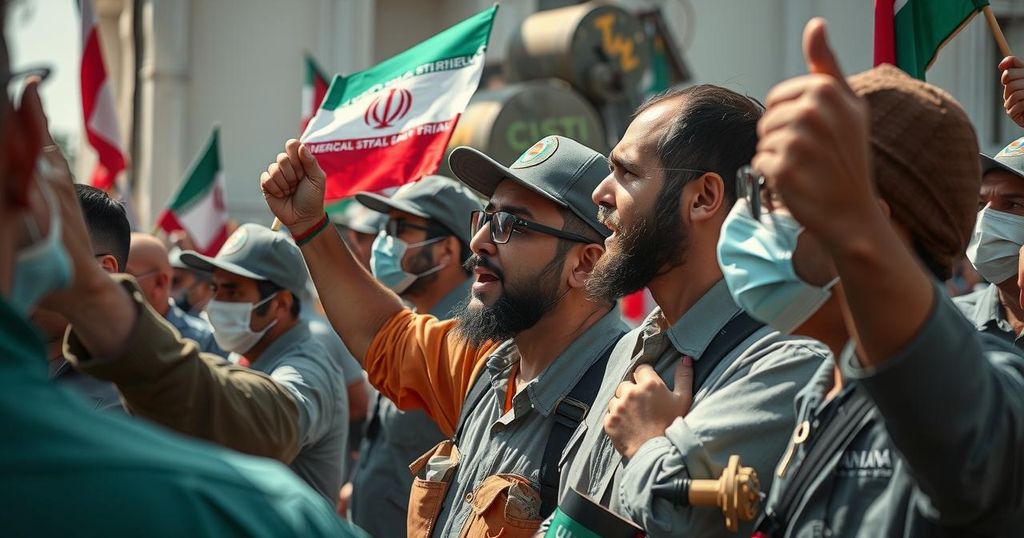On January 13, 2024, Iranian labor organizations and retirees condemned the regime’s anti-labor policies, warning of a mounting crisis for workers. The statement criticized insufficient wages failing to meet living costs, emphasizing an urgent need for change. Protests are increasing in response to these economic hardships, challenging the government’s repressive tactics with calls for solidarity among marginalized groups in pursuit of their rights.
On January 13, 2024, a coalition of labor organizations and retirees in Iran collectively condemned the regime’s anti-labor policies, expressing that these measures have grossly alienated the workforce throughout the nation. The joint statement, which included prominent unions such as the Haftapeh Sugar Cane Workers Union and the Coordinating Committee to Help Establish Labor Organizations, articulated concerns regarding deteriorating conditions and a potential crisis for the working class. It highlighted the essential role of workers as the primary contributors to the economy, stating that their labor drives societal wealth.
Critically, the labor organizations denounced the government’s wage policies as increasingly detrimental, stating that they have only worsened compared to previous years. They observed that a failure to address wage suppression would only exacerbate the current crisis, pushing the working class “closer to the edge of the abyss.” The statement urged that wages should reflect the actual living costs for urban families, as mandated by Article 41 of Iran’s Labor Law, which stipulates that minimum wages must consider inflation and living expenses.
The collective highlighted a significant discrepancy between reported living costs and actual expenses faced by families. While official statistics suggest a monthly cost between 32 and 37 million tomans in urban areas, the organizations estimated that the true cost for a family of four in 2024 is around 40 to 45 million tomans, starkly contrasting with the minimum wage of only 11 million tomans for married workers. This inadequacy has become increasingly burdensome in the context of rising inflation and housing costs.
Omid Nasibi, a member of the Parliament’s Councils and Internal Affairs Commission, acknowledged these dire realities, commenting, “In the current inflationary conditions, the working class is unable to meet the cost of housing rent and livelihood. They are facing serious problems.” He warned that even with a substantial salary increase, the situation would remain unchanged if inflation is not controlled. Although the government plans a 20% salary increase for employees and a potential rise of 30% for workers, these measures appear insufficient against the backdrop of skyrocketing living costs.
Iranian workers currently experience some of the lowest wages globally, exacerbated by inflation and mounting living expenses, straining the working class. The labor groups’ statement stressed the regime’s failure to alleviate these tensions, explaining that its anti-labor approaches have weakened its support among workers and wage earners. They called for solidarity among various oppressed classes – including women, youth, and farmers – to challenge the government’s unfavorable policies.
Amidst this economic turmoil, protests from a diverse array of disenfranchised groups have surged, encapsulating demands for fair wages and improved working conditions. Despite governmental efforts to suppress dissent through security and judicial means, activists argue that these tactics have been largely ineffective in mitigating the growing frustration among the labor force. The collective statement emphasizes an urgent need for unified action, cautioning that without substantial reform, Iran’s economic and social framework may continue to unravel under pressure.
In conclusion, the current economic conditions in Iran reflect a deepening crisis exacerbated by inadequate wages that fail to keep pace with the rising cost of living and pervasive inflation. The labor organizations’ joint statement represents a critical call to action, urging workers and marginalized populations to unite against the regime’s oppressive economic policies. As long as the cost of living outstrips wage increases, the Iranian government will face escalating pressures from essential laborers and citizens who sustain its economy.
The labor unrest in Iran stems from ongoing economic difficulties exacerbated by government policies perceived as anti-labor. Labor organizations have become increasingly vocal about the widening gap between wages and living costs, which has cultivated a challenging environment for workers. As inflation rates soar and essential costs rise, the working class finds itself caught in a precarious situation, leading to collective discontent and protests aimed at demanding fair treatment and adequate compensation.
The situation facing Iran’s working class has reached a critical point, highlighting the detrimental impact of government policies on their economic well-being. The collective denunciation by labor organizations serves as a significant indicator of widespread discontent and a clarion call for unity among various oppressed groups. Without immediate and effective policy changes that address the urgent needs of workers, the social and economic crisis in Iran is likely to deepen, leading to further unrest and instability.
Original Source: irannewsupdate.com






